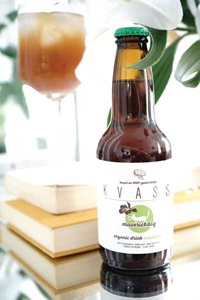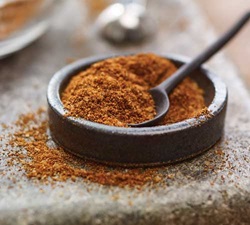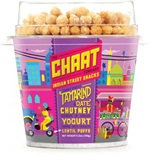
The Future of Flavor
A look at five flavor trends that will resonate with consumers in the coming years and how technology is helping companies take flavor to a whole new level.
Article Content
These days when the subject of food arises—at least among industry professionals, academics, economists, and those in Silicon Valley—it is often to ponder its future. What will food look like in 10, 15, or 20 years? How will we be able to produce enough food to feed a growing population? What technological innovation will be the next big thing?
These are, of course, all important and relevant questions. But it’s important to keep them in perspective. At the reThink Food conference organized by the MIT Media Lab and the Culinary Institute of America and held last month in Napa Valley, Calif., a theme emerged that might serve as a tenet for anyone working in the food industry: The future of food is food. That is, at the end of the day, whatever technology we implement or solution we develop, we need to remember that it always comes back to the food. And what is the No. 1 driver of all food purchases? Flavor.
With insight from more than 20 flavor companies, chefs, and market research experts, here are five flavor trends—alcohol infusion, fermentation, East Africa and Southern India, herbs and botanicals, and maple and honey—to watch in 2018 and beyond.
1. Alcohol Infusion
According to Mintel, craft beer continues to experience growth in the United States. In fact, its share in the beer category nearly doubled from 2010 (5.2%) to 2015 (10.2%). With a focus on continual innovation, the craft beer segment has seen a surge in demand for flavored beer. Overall, as many as three in five U.S. alcohol drinkers say they are interested in fruit-flavored beer, with other flavors, such as spicy, tart/sour, and beer blended with juice, tea, and soft drinks, also showing strong potential (Mintel 2016).
 This cross-category blurring has also led to an interest in beer- and alcohol-flavored food. The trend has taken hold in two categories where flavor innovation is no stranger—ice cream and confectionery. One of the most popular flavors at Sweet Action Ice Cream, a Denver ice cream shop, is Stranahan’s Whiskey Brickle ice cream.
This cross-category blurring has also led to an interest in beer- and alcohol-flavored food. The trend has taken hold in two categories where flavor innovation is no stranger—ice cream and confectionery. One of the most popular flavors at Sweet Action Ice Cream, a Denver ice cream shop, is Stranahan’s Whiskey Brickle ice cream.
“The whiskey is an elemental part of the flavor, and it wouldn’t be the same without it, for sure,” explains Chia Basinger, co-owner of Sweet Action Ice Cream. “The goal on that one was to create a true whiskey ice cream instead of using whiskey as an ‘extra touch’ … Stranahan’s is perfect for it—it’s a high-quality whiskey (and one of the first of the new craft whiskeys in the country), and its flavors are a perfect match for the ice cream and the toffee candy.”
The beer/alcohol-flavored ice cream trend is also filtering down to larger craft brands, such as Graeters, which has collaborated with Braxton Brewing to release limited-time offerings. The companies have partnered to release two beer flavors, and in September they debuted their first ice cream collaboration—Stout & Pretzels Ice Cream—which uses Braxton’s Dead Blow Tropical Stout.
As Basinger noted, alcohol often pairs well with confectionery, so it’s no surprise that beer- and alcohol-flavored candy and chocolate are increasing in popularity. David Horrocks, research chef and member of the global and North American marketing team at International Flavors & Fragrances (IFF), notes that this “blurring of boundaries will continue to be evident in 2018 and beyond.” In fact, he has seen Rosé and Moscow Mule—both trendy alcoholic beverages of late—being introduced into confections.
Brooklyn, N.Y.–based Nunu Chocolates’ entire business is centered around the pairing of beer and chocolate. Not only do owners Andy Laird and Justine Pringle have 10 craft beers on tap at their Café & Tap Room for visitors to enjoy, but they make an assortment of chocolates that feature the craft beers and liquors, such as absinthe and moonshine, in the ganache of their truffles.
Others are taking the ingredient known for flavoring beer—hops—and infusing it directly into foods and beverages. Hop Pop Soda is a caffeine-free, carbonated soda, flavored and bittered with Galaxy and Citra hops that can be enjoyed on its own or as a cocktail mixer. B-Hoppy Hop Candy comes in varietal-specific flavors, including Saaz, Cascade, and Motueka. Charles Martell & Sons coats its full-fat, cow’s milk cheese in a layer of toasted Hallertao Hersbrucker hops, while HopTown Pizza, located just outside of Yakima, Wash., sprinkles its pizzas with Cascade hops sourced from a local farm.
It appears that a prediction by Mindy Segal, pastry chef and owner of HotChocolate in Chicago—that we will begin to see everything and “anything flavored with beer”—may reach the mass market level in the coming year. And food ingredient companies are preparing to meet the demand by developing specialized flavors. In October, Kalsec introduced a range of beer flavors for food applications that feature IPA, lemon shandy, porter, pumpkin, and wheat.
2. Fermentation
Closely tied in many ways to the alcohol infusion trend, the use of fermentation is coming front and center not only as a technique for food preparation but also as a unique flavor profile. The popularity of home brewing in addition to the growing interest in global cuisines has introduced a wider audience to the pungent and tangy flavors created from fermentation.
Denver Chef Jensen Cummings is so passionate about fermentation that he created Brewed Food in 2014 as a “Food Lab & Culinary Movement.” He utilizes beer’s building blocks (yeast, malt, and hops) and brewing processes to “fashion thrilling foodstuffs that blur the line between ales and edibles” (Draft 2017). His creations include wild yeast–fermented kimchi, cherry sriracha fermented with brewing yeast, and bacon rimmed in hop ash.
As an added perk, the fermentation process also creates beneficial bacteria—probiotics—that may positively affect the gut microbiome. “As consumers look to products with simple ingredients, those that serve a dual function—that of imparting taste and functionality—will be increasingly important,” says Edouard Janssen, senior vice president and general manager for Solvay Aroma Performance.
While American consumers are obviously familiar with fermented products such as yogurt, cheese, beer, and bread, they are also increasingly becoming familiar with products like kombucha that tout the health benefits derived from fermentation. The fact that in 2016, beverage giant PepsiCo acquired KeVita—a fermented probiotic and kombucha start-up that launched in 2009 from a kitchen in Ojai, Calif.—is proof that the kombucha trend has gone mainstream. According to Markets and Markets, the global kombucha market is predicted to grow from $600 million in 2015 to $1.8 billion by 2020 (2015).
 China, where kombucha was developed, is certainly not the only country to have a history of fermented beverages. Perhaps kvass, an Eastern European fermented drink that has been around for 1,000 years and is traditionally made with rye bread and veggies, will be the next kombucha. One of only a handful of U.S. kvass manufacturers is start-up Maverick Dog, based in Brooklyn, N.Y. Founded this year, the company produces four varieties of the nonalcoholic tangy beverage: Original, Hops, Cranberry, and Honey.
China, where kombucha was developed, is certainly not the only country to have a history of fermented beverages. Perhaps kvass, an Eastern European fermented drink that has been around for 1,000 years and is traditionally made with rye bread and veggies, will be the next kombucha. One of only a handful of U.S. kvass manufacturers is start-up Maverick Dog, based in Brooklyn, N.Y. Founded this year, the company produces four varieties of the nonalcoholic tangy beverage: Original, Hops, Cranberry, and Honey.
Another product that dates back thousands of years and one that Elizabeth Moskow, culinary director at Sterling-Rice Group, believes will start getting the attention it deserves in the coming years is koji. It’s a fermented product made by treating rice or soy beans with Aspergillus oryzae, a mold that adds a distinct flavor. This is then used to make soy sauce, Chinese fermented black bean paste, Korean fermented bean paste, rice wine, and Japanese miso and sake. What do all those products have in common? A strong umami essence that is caused by koji breaking down proteins to produce glutamate—the amino acid responsible for a rich, savory flavor.
“The umami wave isn’t new for 2018, but it will deepen and broaden in the coming years as consumers look to educate their palate beyond sweet and savory,” says Moskow. “Pickles and brined vegetables—kimchi—were very hot in 2017 as was fermented dairy, but I believe this is just the gateway into exploration of other and deeper fermentation flavor profiles.”
Moskow predicts that the American palate may be ready to explore these “richer and more pungent flavors” within categories such as fermented grain, tofu, and meat. One example is injera, an Ethiopian flatbread made from teff flour. Traditionally, it is made by allowing wild yeast to form during days-long fermentation, resulting in a flatbread with a unique, slightly spongy texture and a tangy, sour taste.
Injera is just one example of a fermented food that most Americans are unaware of. According to Roger Lane, Sensient Flavors’ marketing manager for savory flavors, one need only look to any global cuisine to see the ubiquity of fermented flavors. “If one looks from a global perspective, there are fermented flavors found in almost every culture, and they’re just waiting to be mined for inspiration,” says Lane.
3. East Africa and Southern India
Consumers are demanding new, unique, and authentic flavors that take them to exotic destinations that they may or may not have visited. “Any flavor that transforms a product or menu item into an experience will undoubtedly be popular in 2018 and onward,” says Shannon Cushen, director of marketing at Fuchs North America. “This includes flavors that take global or regional inspiration, have unique or sophisticated ingredients, combine unexpected taste profiles, or have some sort of nostalgic quality. … Consumers are demanding foods that aren’t just for eating; they’re for experiencing.”
Specifically, while Cushen sees Latin, Mediterranean, and Asian cuisines continuing to be popular, she foresees “new ethnic cuisine types and flavors popping up more frequently, like African, Indian, and Eastern European.”
This resonates with McCormick’s newly announced 2018 Flavor Forecast, which lists “A Bite of East Africa” as one of five trends on the company’s radar for the coming year. “East Africa is a treasure trove of flavor,” notes the company. “Finally, the signature seasonings, BBQ marinades, and sauces of Tanzania and Ethiopia are being discovered across the globe.”
 Among these flavors is the Ethiopian berbere spice blend, which contains an array of spices like paprika, allspice, coriander, cardamom, ginger, cinnamon, and red pepper. According to McCormick, “it’s hot, sweet, and citrusy flavor is perfect for chicken stew and meats as well as lentils and vegetables.”
Among these flavors is the Ethiopian berbere spice blend, which contains an array of spices like paprika, allspice, coriander, cardamom, ginger, cinnamon, and red pepper. According to McCormick, “it’s hot, sweet, and citrusy flavor is perfect for chicken stew and meats as well as lentils and vegetables.”
Currently, berbere can be found as a seasoning on some snack food products, such as Spice Foods’ Ethiopian Berbere Dry Roasted Almonds. With other flavors inspired by Argentina and the Middle East, Spice Foods claims its mission is to “bring global destinations to your daily grind.”
The East African spice blend is also showing up on a larger scale in Kashi’s Teff Thins, a line of gluten-free crackers inspired by African culinary recipes. Launched in August 2016, they are available in Tomato Lentil Berbere, Red Sea Salt, and Lemon Chickpea Chili.
Another cuisine that will become more familiar to American diners is that of Southern India. Americans are already familiar with Northern Indian cuisine, which features a strong Persian influence that uses creams and butter in sauces, as well as meats and nuts. Southern Indian cuisine is less well known and is characterized by hot spices, the sour flavor of tamarind, and a heavy use of rice and lentils in stews and dosas (somewhat similar to the Ethiopian injera).
According to Technomic report data supplied by SupHerb Farms, 31% of consumers—including 45% of Gen Zers and 42% of Millennials—would like to see more Indian influences on restaurant menus. Additionally, the data show that 25% of consumers seek out different regional Indian cuisine experiences but that just 17% know the culinary differences among the various regions (2017). This will require restaurants and food manufacturers to educate consumers and offer balance by leveraging products (ingredients, sauces) from known brands to increase consumers’ willingness to try dishes featuring unusual flavors.
This fall, Fuchs North America debuted a South Asian Collection of seasonings, bases, and flavors aimed at this very trend. One of the four seasoning blends—Kerala Style Lamb Curry Seasoning—is inspired by the state in Southern India that rose to fame for its production of spices such as black pepper, cardamom, and cinnamon.
 In the consumer packaged goods world, The Chaat Co., based in New York City, received $1 million in seed funding in August from India-based Jain Farm Fresh Foods to help with the launch of its savory yogurt snacks inspired by the flavors and ingredients of Indian street snacks commonly known as “chaat.” Tangy Sweet Tamarind & Date Chutney is one of five flavors the company offers, and each flavor has crunchy lentil puffs as toppings.
In the consumer packaged goods world, The Chaat Co., based in New York City, received $1 million in seed funding in August from India-based Jain Farm Fresh Foods to help with the launch of its savory yogurt snacks inspired by the flavors and ingredients of Indian street snacks commonly known as “chaat.” Tangy Sweet Tamarind & Date Chutney is one of five flavors the company offers, and each flavor has crunchy lentil puffs as toppings.
4. Herbs and Botanicals
Some of the most innovative flavor combinations surface first in cocktails due to mixologists’ love for experimentation and consumers’ acceptance of more complex flavor profiles in their alcoholic beverages. In the past couple of years, the demand for healthier and fresher ingredients has led to a revolution in the craft cocktail segment. Sweet and sour mix is out, and bartenders are creating housemade juices, syrups, bitters, shrubs, and sodas using fresh herbs, botanicals, and spices.
And now that same movement has inspired the production of mixers and mocktails. “An example of how Generation Z is influencing flavor trends is the drive for more sophisticated low- or no-alcohol beverages with an emphasis on herbal flavors,” notes Marie Wright, vice president and chief global flavorist at WILD Flavors/ADM. “These beverages will be sophisticated—a new era of mocktails. Teas, tonic waters, and ginger beers are regulars in this space and will continue to grow in 2018 and 2019.”
 Gladys Slovis, flavor applications manager at Comax Flavors, agrees with Wright and sees the “popularity of sophisticated herbal and floral flavors being driven by the mocktail trend.” Flavors such as pomegranate elderflower and cucumber ginger will gain ground and become more mainstream. Boundary Waters Brands was founded in 2010 to offer consumers an alternative to standard soda that was more flavorful and featured fresh ingredients. A year later, the company introduced Joia Natural Sodas in five flavors: Blackberry, Pomegranate & Ginger; Pineapple, Coconut & Nutmeg; Grapefruit, Chamomile & Cardamom; Ginger, Apricot & Allspice; and Orange, Jasmine & Nutmeg. The market appears to be receptive, with Panera Bread carrying the brand’s Grapefruit, Chamomile & Cardamom flavor in more than 1,600 of its stores throughout the United States since late 2015.
Gladys Slovis, flavor applications manager at Comax Flavors, agrees with Wright and sees the “popularity of sophisticated herbal and floral flavors being driven by the mocktail trend.” Flavors such as pomegranate elderflower and cucumber ginger will gain ground and become more mainstream. Boundary Waters Brands was founded in 2010 to offer consumers an alternative to standard soda that was more flavorful and featured fresh ingredients. A year later, the company introduced Joia Natural Sodas in five flavors: Blackberry, Pomegranate & Ginger; Pineapple, Coconut & Nutmeg; Grapefruit, Chamomile & Cardamom; Ginger, Apricot & Allspice; and Orange, Jasmine & Nutmeg. The market appears to be receptive, with Panera Bread carrying the brand’s Grapefruit, Chamomile & Cardamom flavor in more than 1,600 of its stores throughout the United States since late 2015.
McCormick’s “Drink to Your Wellness” 2018 Flavor Forecast trend aligns perfectly with the increase in botanicals, herbs, and spices appearing in beverages. “These wholesome drinks add uplifting ingredients and robust flavors like cucumber, dandelion greens, ginger, turmeric, and cayenne pepper,” said the company in its report. The trend is illustrated with two beverages: Spiced Cucumber & Apple Morning Boost and Pineapple Turmeric Mocktail with Dandelion Greens.
Mike Kostyo, senior publications manager for Datassential, explains that as consumers’ definition of health has evolved, so has what they are looking for in their food and beverages. “Healthy 1.0 was focused on bad things being taken out of food, like fat and calories,” says Kostyo. “Healthy 2.0 was focused on feel-good terms like farm-to-table and organic, but Healthy 3.0 focuses on functional foods and positive nutrition. ‘I want my food to give me energy, support wellness, detoxify me, etc.’”
“The clean label and organic trends aren’t going anywhere,” says Kip Murphy, marketing manager for Virginia Dare. “Any ingredients that meet these requirements and offer natural benefits make those new offerings even more enticing.” According to Mintel’s Global Food & Drink Trends 2018 report, chamomile, lavender, and lemon balm are the leading herbs and spices used in global food and drink with relaxation properties launched from September 2016 through August 2017 (2017).
While prevalent in beverages, botanicals and herbs are also appearing in food products. “Lavender, basil, hibiscus, and cherry blossom are all popping up in beverages and baked goods,” says Murphy.
“Lemongrass is also seen more widely, especially in tea and other beverages, and will find its way into frozen desserts and more delicate baked goods, like cookies and confections,” says Kara Nielsen, vice president of trends and marketing for CCD Innovation. This medicinal plant is said to aid in the treatment of a variety of digestive ailments and even the common cold.
5. Maple and Honey
Caramel has pretty much ruled the sweet brown category for years, and while it is not disappearing, it may take a back seat to maple and honey. Both are appealing to consumers because they are natural ingredients that have the ability to add sweetness and depth of flavor to practically any food and beverage category.
This trend is probably the furthest along in terms of adoption, as evidenced by the launch this fall of Starbucks’ new Maple Pecan Latte. “Seasonal or limited-edition flavors will continue to shine,” says IFF’s Horrocks, “and right now maple is having a moment.”
According to Technomic’s MenuMonitor, mentions of maple are up about 85% in nonalcoholic beverages between the second quarter of 2016 and the second quarter of 2017 (Market Watch 2017). Positioned to oust pumpkin spice as the top seasonal flavor, maple is showing signs of living well beyond the brief fall limited-time-offering period. This makes sense given that maple syrup is harvested in the spring and is already associated with year-round foods like oatmeal and waffles.
Honey is on a similar trajectory. “Honey has a very well-known profile as a sweetener that people are really familiar with,” said Lindsey Oostema, senior marketing specialist at Synergy Flavors. “It has this natural connotation, so I think that consumers are really drawn to it.” At a time when artificial sweeteners of any kind can immediately turn consumers off, both maple and honey provide a health halo effect because they’re known as natural sweeteners and they have the added benefit of providing a nuanced and varietal flavor to food and beverage products.
“We are tracking increases in sweet flavors such as maple, honey, and cinnamon spice used beyond traditional bakery applications into beverage, snack, and savory products,” confirms Luis Fernandez, vice president of strategic development for flavors at Mane.
Technomic is also tracking a similar trajectory, according to its 2017 Flavor Consumer Trend Report. Mentions of maple on burgers is up 31.3% year over year, while honey mentions in fried chicken dishes have increased 12.5% on menus. In addition, more consumers now (46%) than in 2015 (42%) prefer honey glazes and marinades for chicken, according to Technomic’s 2017 Center of the Plate: Poultry Consumer Trend Report.
 Hot honey, a chili-infused honey condiment, has been poised to become the new sriracha for a few years now, appearing on an increasing number of menus and in grocery stores. A well-known brand, Mike’s Hot Honey, got its inspiration back in 2003, when founder Michael Kurtz was first introduced to the concept of chili pepper–infused honey while living in Brazil. Upon his return to the states in 2004, he began experimenting with honey infusion, but it wasn’t until 2010 that he officially debuted Mike’s Hot Honey.
Hot honey, a chili-infused honey condiment, has been poised to become the new sriracha for a few years now, appearing on an increasing number of menus and in grocery stores. A well-known brand, Mike’s Hot Honey, got its inspiration back in 2003, when founder Michael Kurtz was first introduced to the concept of chili pepper–infused honey while living in Brazil. Upon his return to the states in 2004, he began experimenting with honey infusion, but it wasn’t until 2010 that he officially debuted Mike’s Hot Honey.
On the foodservice side, Popeyes Louisiana Kitchen recently introduced a new limited-time offering featuring its Crunchy Tenders drizzled with a Red Hot Honey Sauce, moving this flavor trend squarely in the direction of mass market attention thanks to the chain’s 2,600 locations around the world.
Technomic predicts “continued growth of both maple- and honey-flavored savory dishes, as well as an increase in demand for maple-based icy beverages and desserts” (2017).
The Millennial Factor
Many factors influence the development of flavor trends over time, but today one factor dwarfs all others—the Millennials (who were born between 1982 and 2000). What is now the largest living generation in the United States, the Millennials have a lot of interest in every aspect of their food, including flavor (U.S. Census Bureau 2015).
“The consumers that are really driving these trends are Millennials, not surprisingly,” says Fuchs’ Cushen. “They are curious about the world; even if they’ve never been to Thailand, they want to experience Thai food and know what it’s like. Millennials are challenging food companies to come up with more creative and inventive products.”
This vocal and passionate consumer group seeks many things when it comes to their food, but three values are exerting the greatest influence on new product development and flavor innovation. These drivers are a desire to experience new bold and authentic flavors, clean labels with simple ingredients, and food that is going to improve one’s health and wellness. Each flavor trend—alcohol infusion, fermentation, East Africa and Southern India, herbs and botanicals, and maple and honey—meets at least one, if not all, of these consumer demands, which is why the contributing experts see them as “the ones to watch” in 2018 and beyond.
“Overall, the palette of flavor tonalities consumed by individuals is increasing,” says Mane’s Fernandez. “Taste curiosity and diversity is on the rise. … Nevertheless, truly unfamiliar tastes take years, if not decades, to find their way into people’s everyday habits.”
The more that the food industry can balance what’s new with what consumers are already familiar with, the easier, and perhaps faster, it will be for them to adopt new flavors. Additionally, imparting new flavors into more categories of food enables more exposure and an increased level of comfort.
“Traditionally, beverage and confectionery are extremely innovative categories as far as flavor is concerned,” says Fernandez. “But flavor diversity is also expanding rapidly in the culinary space of savory snacks, ready-to-eat meals, and sauces.”
And that means that as consumers walk down the aisles of the grocery store next year, they will likely find themselves surprised—and even delighted—to see how these trending flavors pop up everywhere from the chip aisle to the freezer section.
IFTNEXT is made possible through the generous support of Ingredion Incorporated, IFT’s Platinum Innovation Sponsor.
The IFTNEXT initiative is a heightened, purpose-drive commitment to bringing provocative ideas and discoveries together to inspire thoughtful, important conversations that challenge conventional approaches with the goal of informing global issues related to the science of food.


 In 2015, the Media Lab researchers developed the OpenAg Personal Food Computer—a contained growing environment that uses rob…
In 2015, the Media Lab researchers developed the OpenAg Personal Food Computer—a contained growing environment that uses rob…




